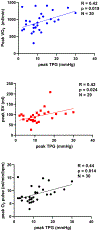Pulmonary Vascular Pressures and Gas Exchange Response to Exercise in Heart Failure With Preserved Ejection Fraction
- PMID: 32750488
- PMCID: PMC7704759
- DOI: 10.1016/j.cardfail.2020.07.009
Pulmonary Vascular Pressures and Gas Exchange Response to Exercise in Heart Failure With Preserved Ejection Fraction
Abstract
Elevated left ventricular filling pressure (measured as mean pulmonary capillary wedge pressure) at rest or with exercise is diagnostic of heart failure with preserved ejection fraction. However, the capacity of the right ventricle to compensate for a high mean pulmonary capillary wedge pressure and thus maintain an appropriate transpulmonary gradient (TPG) and perfusion of the pulmonary capillaries is likely an important contributor to gas exchange efficiency and exercise capacity. Therefore, this study aimed to determine whether a higher TPG at peak exercise is associated with superior exercise capacity and gas exchange. Gas exchange data from dyspneic patients referred for exercise right heart catheterization were retrospectively analyzed and patients were split into two groups based on TPG. Patients with a higher TPG at peak exercise had a higher peak VO2 (1025 ± 227 vs 823 ± 276, P = .038), end-tidal partial pressure of carbon dioxide (42.2 ± 7.9 vs 38.0 ± 4.7, P = .044), and gas exchange estimates of pulmonary vascular capacitance (408 ± 90 vs 268 ± 108, P = .001). A higher TPG at peak exercise correlated with a higher peak oxygen uptake, O2 pulse, and stroke volume (R = 0.42, 0.44 and 0.42, respectively, all P < 0.05). These findings indicate that a greater TPG with exercise might be important for improving exercise capacity in heart failure with preserved ejection fraction.
Keywords: Transpulmonary gradient; cardiopulmonary exercise test; exercise intolerance; right heart catheterization.
Copyright © 2020 Elsevier Inc. All rights reserved.
Conflict of interest statement
Figures
Similar articles
-
Diagnostic utility of sub-maximum cardiopulmonary exercise testing in the ambulatory setting for heart failure with preserved ejection fraction.Pulm Circ. 2020 Nov 25;10(4):2045894020972273. doi: 10.1177/2045894020972273. eCollection 2020 Oct-Dec. Pulm Circ. 2020. PMID: 33282205 Free PMC article.
-
Simultaneous Measurement of Lung Diffusing Capacity and Pulmonary Hemodynamics Reveals Exertional Alveolar-Capillary Dysfunction in Heart Failure With Preserved Ejection Fraction.J Am Heart Assoc. 2021 Aug 17;10(16):e019950. doi: 10.1161/JAHA.120.019950. Epub 2021 Aug 7. J Am Heart Assoc. 2021. PMID: 34369164 Free PMC article.
-
Atrial Fibrillation in Heart Failure With Preserved Ejection Fraction: Association With Exercise Capacity, Left Ventricular Filling Pressures, Natriuretic Peptides, and Left Atrial Volume.JACC Heart Fail. 2017 Feb;5(2):92-98. doi: 10.1016/j.jchf.2016.10.005. Epub 2016 Dec 21. JACC Heart Fail. 2017. PMID: 28017355
-
Relative Impairments in Hemodynamic Exercise Reserve Parameters in Heart Failure With Preserved Ejection Fraction: A Study-Level Pooled Analysis.JACC Heart Fail. 2018 Feb;6(2):117-126. doi: 10.1016/j.jchf.2017.10.014. JACC Heart Fail. 2018. PMID: 29413366 Free PMC article. Review.
-
Pulmonary hypertension due to left heart diseases.J Am Coll Cardiol. 2013 Dec 24;62(25 Suppl):D100-8. doi: 10.1016/j.jacc.2013.10.033. J Am Coll Cardiol. 2013. PMID: 24355634 Review.
Cited by
-
Exercise haemodynamics in heart failure with preserved ejection fraction: a systematic review and meta-analysis.ESC Heart Fail. 2022 Oct;9(5):3079-3091. doi: 10.1002/ehf2.13979. Epub 2022 Jun 24. ESC Heart Fail. 2022. PMID: 35748109 Free PMC article.
References
-
- Naeije R, Vachiery JL, Yerly P, Vanderpool R. The transpulmonary pressure gradient for the diagnosis of pulmonary vascular disease. Eur Respir J. 2013;41:217–223. - PubMed
MeSH terms
Grants and funding
LinkOut - more resources
Full Text Sources
Medical


